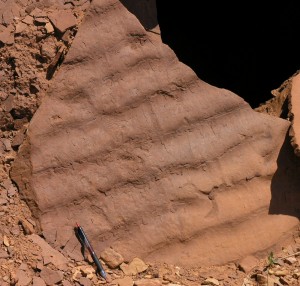Sculpture
The Texas Sculpture Walk is such fertile ground for bringing out mathematical themes in contemporary sculpture that we could do an entire tour just within this one section of the District. We’re not going to indulge in that right now, to keep this set of tour ideas broadly based in the whole arts district, but I can’t resist mentioning just one of the sculptures, pictured above: Spirit Inner Columns by Jesus Moroles, just at the top of the stairs leading up to the Walk. In the picture, the sculpture might appear to be just three stacks of rectangular pieces of stone. However, in person, you can see that between each rectangular slab there is a smaller piece of stone, and taken together those smaller pieces create a graceful, flowing curve hidden amongst the uniform slabs. Each of the smaller pieces itself is really just a slab of stone, so this artwork shows how a curve can be understood as an assemblage of very numerous infinitesimal pieces, each on its own essentially straight and featureless. This is precisely the same insight that allowed Archimedes to compare the volumes of a sphere and cylinder over two millennia ago, and which underlay the invention of calculus in the 17th century. It underscores how both art and math can be about seeing the world with fresh eyes that will bring out heretofore unrecognized structure and detail.
A Mathematical Fossil
It’s worth stopping at the landing halfway up to the Texas Sculpture Walk to show participants this image. 
Tell them that this is a mathematical fossil, and that you’ll explain what you could possibly mean by that when they have found this same pattern somewhere nearby. It won’t take them long to find it in the bottom surface of the fountain/artificial stream that runs by this landing. So what is this image? It is the fossilized remnant of a prehistoric streambed, and it shows the same ripple patterns that you can find in almost any stream today that has a sandy bottom. There’s a very characteristic shape to the ripples: very shallow slope on the upstream side, and a much steeper slope on the downstream side. These patterns arise because of the dynamics of waves in moving water. A very significant topic in mathematics is the analysis of wave phenomena, and that type of mathematics can be used to understand and derive the ripple patterns seen in this fossil, proving that the math we do today was equally valid millions of years ago. Notice that not only do the waves in a stream mold the streambed into this shape, but this shape affects how the water flows by, so the engineers that created this fountain can use the results of this mathematics to create a more naturalistic environment tucked within the urban setting of the Dallas Arts District.


